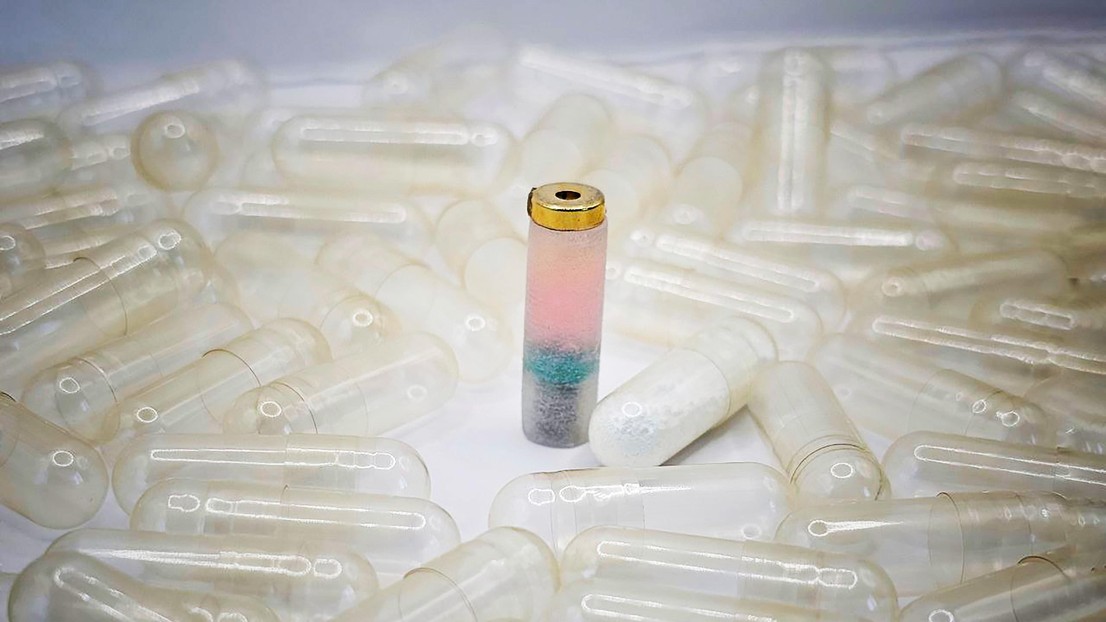
MEDS (Magnetic Endoluminal Deposition System). 2025 LAFT EPFL CC BY SA
EPFL researchers have demonstrated the first pill-sized bioprinter that can be swallowed and guided within the gastrointestinal tract, where it directly deposits bio-ink over damaged tissues to support repair.
Soft tissue injuries of the gastrointestinal tract, like ulcers or hemorrhages, can currently be treated only with some form of surgery, which is invasive and may not result in permanent repair. Bioprinting is emerging as an effective treatment that deposits biocompatible 'ink' - often made of natural polymers derived from seaweed - directly over the site of tissue damage, creating a scaffold for new cell growth. But like traditional surgical tools, these kinds of bioprinters tend to be bulky and require anesthesia.
At the same time, 'untethered' technologies are being developed to perform medical interventions without a physical connection to external equipment. For example, ingestible 'smart capsules' can be guided to drug delivery sites using external magnets. But these devices are designed to travel through liquids, and their movements become unpredictable when they touch the tissue wall.
By combining the principles of in-situ bioprinters with the drug release concepts of smart capsules, we can envision a new class of device: a pill-sized, swallowable bioprinter.
Bioprinting, on the other hand, requires tissue contact. Now, a team from the Laboratory for Advanced Fabrication Technologies in EPFL's School of Engineering has created MEDS (Magnetic Endoluminal Deposition System): the first ingestible bioprinter that can be guided to disease sites to print tissue within the body. Recently published in Advanced Science, the technology opens the door to a new modality of non-invasive medical intervention.
"By combining the principles of in-situ bioprinters with the drug release concepts of smart capsules, we can envision a new class of device: a pill-sized, swallowable bioprinter," says lab head Vivek Subramanian.
Minimally invasive repair
MEDS is designed like a ballpoint pen with a spring tip that releases ink - except here, the device is much smaller, and the 'ink' is a living bio-gel. About the size of a pill, MEDS contains a tiny chamber of bio-ink and a spring-plunger mechanism that pushes the material out. With no on-board electronics, the release is switched on by an external near-infrared laser beam that safely penetrates the body's tissues. As the bio-ink emerges, the capsule is steered with precision by an external magnet mounted on a robotic arm, much like guiding a joystick.
In their experiments, the EPFL team used their bioprinter to repair artificial ulcers of various sizes on simulated gastric tissue, and even to seal a simulated hemorrhage. In in-vivo experiments performed at an accredited animal research facility in the US, the researchers also successfully used their device to deposit bio-ink in the gastric tracts of rabbits. In these experiments, the team tracked the capsule's movements using x-ray fluoroscopy, demonstrating the potential of the device - which can be retrieved orally using magnet guidance - for minimally invasive repair.
The researchers emphasize that in addition to protecting ulcers from gastric juices, the bio-ink itself can be combined with medicine or cells to further boost tissue repair.
"In our controlled lab experiments, our cell-laden bio-ink retained its structural integrity for over 16 days, suggesting its potential as a 'micro-bioreactor' that can release growth factors and recruit new cells for wound healing," says PhD student Sanjay Manoharan.
He notes that while these findings are encouraging, their applicability in-vivo will need to be validated in future studies. "Overall, our results support the foundational role of MEDS in future bioprinting applications. Next, we plan to extend its capabilities into blood vessels and the tissues of the abdominal wall (peritoneum)."






